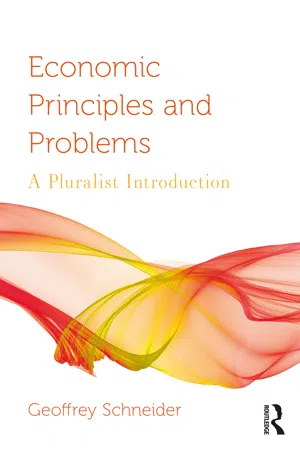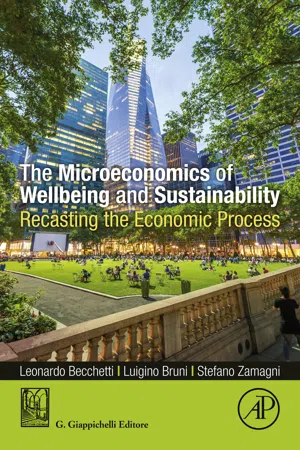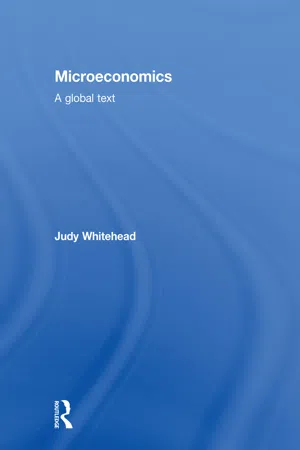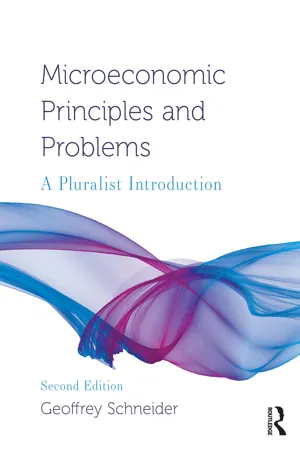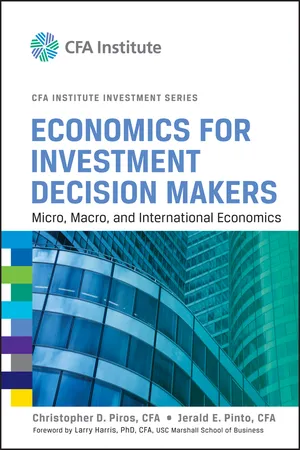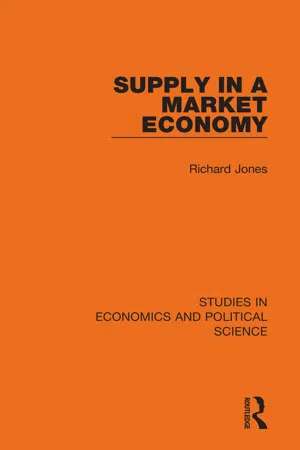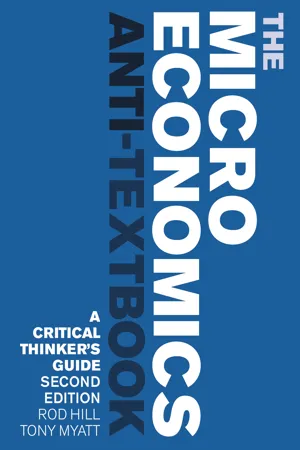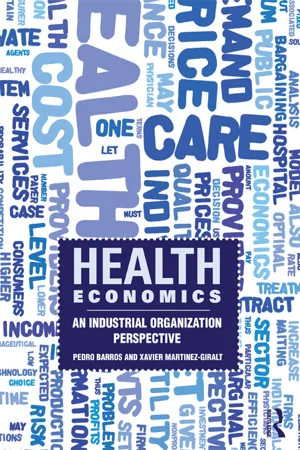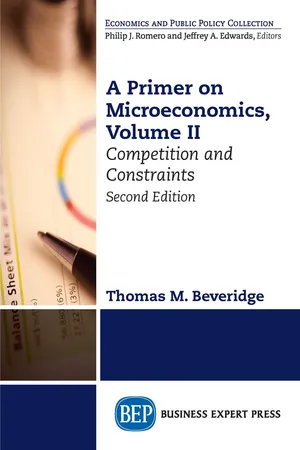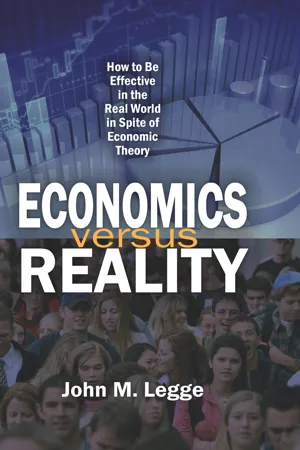Economics
Perfect Competition Graphs
Perfect competition graphs depict the market structure characterized by many small firms producing identical products, with no barriers to entry or exit. The demand and supply curves intersect at the equilibrium price and quantity, where firms operate at the minimum point of their average total cost curve. In the long run, firms earn normal profits, and the market achieves allocative and productive efficiency.
Written by Perlego with AI-assistance
Related key terms
Related key terms
1 of 4
Related key terms
1 of 3
12 Key excerpts on "Perfect Competition Graphs"
- eBook - ePub
Economic Principles and Problems
A Pluralist Introduction
- Geoffrey Schneider(Author)
- 2021(Publication Date)
- Routledge(Publisher)
One of your tasks as a student of economics is to evaluate these positions. Do you see markets as mostly competitive, needing only minor tweaks to achieve economic efficiency? Or do you see markets as mostly dominated by powerful interests, requiring major efforts by citizens and governments to reign in and correct the power imbalances? There is no right answer to these questions, and brilliant economists have come down on both sides of the issues. This is one of the crucial areas of economic debate because it shapes fundamentally one’s belief in how much the government should regulate markets and how many of society’s economic decisions the government should leave up to markets.14.6 Conclusion
This chapter described the mainstream economics model of perfectly competitive markets. Large numbers of firms in perfectly competitive markets offer homogeneous products for sale at prices determined by market supply and demand. Prices are not influenced by individual buyers or sellers. Firms cannot earn economic profits in the long run due to the ease of entry into the market.In order to solve problems involving tables in models of perfectly competitive markets in the short run, undertake the following steps:- Complete the table you are given in the problem using the formulas for the various costs and revenues.
- Determine the profit-maximizing level of output by comparing price and marginal cost. The firm should produce every unit for which P ≥ MC (beginning after the minimum AVC).
- Compare total revenue and total cost at the profit-maximizing level of output to determine the amount of economic profit or loss.
- Identify whether or not the firm is earning an economic profit (TR > TC, P > ATC), normal profit (TR = TC, P = ATC), or economic loss (TR < TC, P < ATC) based on comparing total revenue and total cost or price and average total cost.
- Put the demand curve (D) in the appropriate spot: D goes above the minimum ATC if the firm is earning an economic profit; D is tangent to the minimum ATC if the firm is earning a normal profit. D is between the minimum AVC and the minimum ATC if the firm is losing money but staying open (if the firm is losing less than its total fixed cost).
- eBook - ePub
The Microeconomics of Wellbeing and Sustainability
Recasting the Economic Process
- Leonardo Becchetti, Luigino Bruni, Stefano Zamagni(Authors)
- 2019(Publication Date)
- Academic Press(Publisher)
Recherches is partial, in that it refers to the price and quantity variables in a market isolated from the rest of the economy. Cournot's approach was taken up and perfected by Alfred Marshall, who defined a perfectly competitive equilibrium as the state a market would be in if all decision-making entities, and companies in particular, were devoid of market power. To be precise, a market is perfectly competitive in which:- agents are maximizers: producers who transform inputs into outputs maximize economic profit within cost constraints; consumers who buy the outputs maximize their utility function within their income constraints; agents' decisions in the market are independent of each other; there are no coalitions or collusion, and production and consumption decisions do not create external effects;
- the number of buyers and sellers is sufficiently high that no one is able to exert a significant influence on the quantities bought or sold in the market; the intensity of competition in the market is measured by the number of players in a certain sector, from which it follows that agents are price-takers;
- producers and consumers have complete information about the possibilities of production and consumption, thus there are neither uncertainties nor information asymmetries between agents.
As we will see, every deviation from one or more of these ideal market conditions leads, depending on the case, to monopolistic competition, either to monopoly or oligopoly. In this sense we can state that the theory of perfect competition constitutes a sort of benchmark against which other market structures can be defined and analyzed, which we will discuss in the next chapter.One final important observation. Competition is the flip side of resource scarcity: only in a world without either material and/or immaterial scarcity would there be no need for competition. There is competition even in command economies – as were those of the Soviet bloc until 1989, the year the Berlin Wall fell – but of a different sort than what is prevalent in market economies. Thus the question to address is not whether or not to abolish competition, which is impossible, but to decide which type of competition we want to incline toward, either positional (the current prevalent form) or cooperative . We will focus on this in Chapters 10 and 11 - eBook - ePub
Microeconomics
A Global Text
- Judy Whitehead(Author)
- 2014(Publication Date)
- Routledge(Publisher)
9 The Perfectly Competitive MarketEquilibrium of the Firm and Industry in Short-run and Long-run ; Perfect Competition and Economic Efficiency ; Industry Dynamics: Changes in Demand, Costs and Taxes .The market structure of Perfect Competition is often considered a highly desirable one particularly from the point of view of economic efficiency in a static, distributive sense. This is in consonance with the view that trading in increasingly competitive markets is, in theory, beneficial to economic welfare because of the greater efficiency in the use of economic resources. While this may or may not hold true in reality, it is nevertheless of importance to understand the intricacies and mechanics of this model which has received so much attention.Perfect Competition is the centrepiece of the traditional theory of the firm. It is one of the four basic models of market structure that make up the traditional theory of the firm. The others are Monopoly, Monopolistic Competition and Oligopoly. As a model of market structure, it is used to explain and predict the behaviour of firms which are part of this industry. Furthermore, as one of the so-called ‘marginalist’ models of the firm, the firm is theorized to maximize profits by following the ‘marginalist’ rule of equating marginal revenue with marginal cost.These marginalist models are later contrasted with the more modern alternative models of the firm which are included in the study of market structure. Newer models have proliferated since the 1930 and particularly since the 1950s and include the Managerial, Behavioural, Average-cost/Mark-up Pricing and Entry-Prevention models.9.1 Assumptions and Fundamentals of the Model
9.1.1 Basic assumptions
The basic assumptions of the model of Perfect Competition are as follows:- There are many buyers and sellers (firms) in the industry. There are so many buyers and sellers that no single buyer or seller can influence price or output sufficiently to alter the equilibrium of the industry.
- eBook - ePub
Microeconomic Principles and Problems
A Pluralist Introduction
- Geoffrey Schneider(Author)
- 2024(Publication Date)
- Routledge(Publisher)
One of your tasks as a student of economics is to evaluate these positions. Do you see markets as mostly competitive and stable, needing only minor tweaks to achieve economic efficiency? Or do you see markets as mostly dominated by powerful interests and creating negative impacts on workers and the environment, requiring major efforts by citizens and governments to rein in and correct the power imbalances and unsavory behaviors? There is no right answer to these questions, and brilliant economists have come down on both sides of the issues. This is one of the crucial areas of economic debate because it fundamentally shapes one’s belief in how much the government should regulate markets and how many of society’s economic decisions the government should leave up to markets.14.6 CONCLUSION
This chapter described the mainstream economics model of perfectly competitive markets. Large numbers of firms in perfectly competitive markets offer homogeneous products for sale at prices determined by market supply and demand. Prices are not influenced by individual buyers or sellers. Firms cannot earn economic profits in the long run due to the ease of entry into the market.In order to solve problems involving tables in models of perfectly competitive markets in the short run, undertake the following steps:- Complete the table using the formulas for the various costs and revenues.
- Determine the profit-maximizing level of output by comparing price and marginal cost. The firm should produce every unit for which P
- eBook - ePub
Economics for Investment Decision Makers
Micro, Macro, and International Economics
- Christopher D. Piros, Jerald E. Pinto(Authors)
- 2013(Publication Date)
- Wiley(Publisher)
In the long run, the perfectly competitive firm will operate at the point where marginal cost equals the minimum of average cost, because at that point, entry is no longer profitable: In equilibrium, price equals not only marginal cost (firm equilibrium) but also minimum average cost, so that total revenues equal total costs. This result implies that the perfectly competitive firm operates with zero economic profit. That is, the firm receives its normal profit (rental cost of capital), which is included in its economic costs. Recall that economic profits occur when total revenue exceeds total cost (and therefore economic profits differ from accounting profits). With low entry cost and homogeneous products to sell, the perfectly competitive firm earns zero economic profit in the long run.Exhibit 4-10 illustrates the long-run equilibrium position of the perfectly competitive firm. Note that total revenue equals price ($4.50) times quantity (QE) and total cost equals average cost ($4.50) times quantity (QE).EXHIBIT 4-10 Perfectly Competitive Firm’s Long-Run EquilibriumThe long-run marginal cost schedule is the perfectly competitive firm’s supply curve. The firm’s demand curve is dictated by the aggregate market’s equilibrium price. The basic rule of profit maximization is that MR = MC, as is the case in long-run equilibrium. The firm’s demand schedule is the same as the firm’s marginal revenue and average revenue. Given its cost of operation, the only decision the perfectly competitive firm faces is how much to produce. The answer is the level of output that maximizes its return, and that level is where MR = MC. The demand curve is perfectly elastic. Of course, the firm constantly tries to find ways to lower its cost in the long run.4. MONOPOLISTIC COMPETITION
Early in the twentieth century, economists began to realize that most markets did not operate under the conditions of perfect competition.5 Many market structures exhibited characteristics of strong competitive forces; however, other distinct noncompetitive factors played important roles in the market. As the name implies, monopolistic competition is a hybrid market. The most distinctive factor in monopolistic competition is product differentiation . Recall the five characteristics from Exhibit 4-1 - eBook - ePub
- Richard Jones(Author)
- 2021(Publication Date)
- Routledge(Publisher)
It has been argued above that the so-called theory of the firm is more properly described as a theory of market supply, and as such the most widely adopted model is that of the perfectly competitive market. This is the least (descriptively) realistic model which has been developed by economists. It is this characteristic which is felt by critics and supporters to be the greatest weakness and strength of the model, as the case may be. That is to say, it is this feature of the model which has brought it into most disrepute but which, at the same time. is claimed to be its greatest strength. Those who believe that the perfectly competitive model has a significant contribution to make, argue that the economist's main interest in the firm is to derive the industry supply curve and that it is only under conditions of perfect competition that the concept of a supply curve attains the degree of precision and unambiguity necessary to its use in market models of supply and demand. Under conditions of monopoly the supply curve has a special and restricted meaning, while under conditions of monopolistic competition the concept of the industry is itself in a somewhat nebulous position.II. Perfect Competition1
The conditions necessary to the existence of a perfectly competitive market are as follows: a homogeneous product, a large number of relatively small producers, perfect information in the market place, and free and easy exit and entry into the market. Under these conditions no individual producer can influence the price charged in the market, nor can abnormal profits exist in the long run.2 Price is determined by the market and all producers are price takers; that is, the conditions described guarantee an impersonal market in which the forces of supply and demand rule. It will be appreciated that the phrase 'a competitive market' has rather a special meaning in economics. The economist would not use this expression to describe the market for washing powders, for example. The businessmen operating in that market, however, most probably feel that their market is intensely competitive.The short-run behaviour of the firm in a perfectly competitive market will now be considered. Input prices are taken to be fixed. The objective of the firm is to select that rate of output at which profits will be maximised. Price will be simultaneously determined, of course. It can be argued with some force that it is incorrect to dignify this procedure as taking a pricing decision. Price is determined by the market and profit maximisation is a condition of survival. - eBook - ePub
The Economics of Small Business
An Introductory Survey
- Roger A McCain(Author)
- 2018(Publication Date)
- WSPC(Publisher)
for a marginal cost of $99.01 for the next unit produced. As usual, this is an approximation, and the smaller the change in output we use, the better the approximation is.Figure 3 is a picture of marginal cost for our spreadsheet example firm, together with average cost as output varies.As before, the output produced is measured by the distance to the right on the horizontal axis. The average and marginal cost are on the vertical axis. Average cost is shown by the lighter grey curve, and marginal cost in darker grey. Notice how the marginal cost rises to cross average cost at the lowest point of the average cost curve.1.2.Demand and Equilibrium
One of the most familiar ideas from the theory of perfect competition is that, from the point of view of the seller, the price is given. We say that the demand curve for a perfectly competitive firm is infinitely elastic. In fact, the demand curve for a perfectly competitive firm is a “horizontal line corresponding to the going price.”And that makes sense, because the price in a perfectly competitive market is determined by supply and demand — not by the seller or the buyer. Conversely, so far as the seller or the buyer is concerned, the price must be a given, since it is determined by supply and demand. The seller has no control over the price, and to say that the seller has no control over the price is to say that the price is given — a constant, a horizontal line — from the point of view of the seller. Economists sometimes express this by saying that the price is “parametric,” meaning that while it may change from time to time, it does not change in response to the firm’s output decision.This assumption that price is parametric simplifies the maximization of profit. The rule for maximization of profit for a perfectly competitive firm is: increase output untilNotice, in Figure 3 - eBook - ePub
The Microeconomics Anti-Textbook
A Critical Thinker's Guide - second edition
- Rod Hill, Tony Myatt(Authors)
- 2021(Publication Date)
- Zed Books(Publisher)
Figure 6.5 , this occurs at an output of 400 units. Once the quantity is determined in this way, the demand curve determines the price, at $7 per unit.Figure 6.5 Non-competitive firms don’t have a supply curveAs shown in the right-hand diagram, if demand shifted to D2 (with associated marginal revenue of MR2 ) the new marginal revenue curve would cut the marginal cost curve at the same point as before. Therefore, the firm would produce the same amount, but it would now sell the output at a price of $5. This shows that there is no unique price necessary to induce a given supply, and therefore no supply curve. This is the case for any non-competitive firm.1.4 MonopolyMonopoly is the simplest non-competitive market structure since, by definition, there is only one seller. Maintenance of a monopoly position requires barriers to entry associated with: (1) control over at least one crucial input; (2) economies of scale; (3) technological superiority; or (4) a government-created barrier such as patent protection. If the barriers to entry are low, the threat of competitors entering the market would affect the monopolist’s pricing decision. (Such a market is referred to as “contestable”.) To keep things simple, we’ll focus on the case where barriers to entry are high.Comparing monopoly to perfect competitionSuppose all the firms in a perfectly competitive industry were taken over and merged into a single monopolistic supplier. What would be the effect on efficiency and the distribution of income?The key element in the comparison of the two industry structures is the dual role played by the competitive firms’ marginal cost curves. As shown in Figure 6.6 , their (horizontal) summation is the supply curve under perfect competition; but under monopoly that same summation is simply the monopolist’s marginal costs.Figure 6.6 Monopoly versus perfect competitionUnder perfect competition, demand and supply intersect at point A. After all the firms are merged, however, the monopoly maximizes its profit by equating marginal cost to marginal revenue at point B. Given output of QM , the demand curve determines the price, PM - eBook - ePub
Health Economics
An Industrial Organization Perspective
- Xavier Martinez-Giralt, Pedro Barros(Authors)
- 2013(Publication Date)
- Routledge(Publisher)
24.1 The perfectly competitive market
A perfectly competitive market is characterized by a large number of buyers and sellers, so that none of them has the capacity to affect the market price at which transactions take place. There are very few markets in the real economies that fit in this pattern, however there are several reasons that justify its study. On the one hand, it is a market with a simple functioning mechanism that can be used as a reference to elaborate more complex models closer to real situations. On the other hand, the equilibrium of a perfectly competitive market (that is, the market price and the market allocation) shows two important properties: the allocation obtained is efficient i.e. is the best possible allocation of resources, and this equilibrium does not need any intervention from a public authority. To be precise, we first present the assumptions of the model and then will characterize the equilibrium.4.1.1 Assumptions
The model of perfect competition is based on eight assumptions fully characterizing the framework where the agents take their decisions and their behavior.Structural assumptions
ASSUMPTION 4.1 The model is static and of partial equilibrium.This assumption means that the analysis does not contemplate a temporal dimension. Instead, all agents make their decisions at the same time without being able to transfer goods and services either from the past to the present, or from the present to the future. Also, the model only studies the market for a single commodity. Thus, no potential interactions among different goods and services are included in the decision-making process of the agents. In plain words, this set-up considers very simple agents only aware of the present and able to take decisions only on a single product. - eBook - ePub
A Primer on Microeconomics, Second Edition, Volume II
Competition and Constraints
- Thomas M. Beveridge(Author)
- 2018(Publication Date)
- Business Expert Press(Publisher)
Our measure of allocative efficiency is to check and see if, at the chosen output level, price equals long-run marginal cost. Recall that price reflects marginal benefit. To produce the “right” output level, the firm (and industry) must expand production if marginal benefit exceeds marginal cost and must reduce output level if marginal cost exceeds marginal benefit. At the P = LRMC output level, no further Pareto-efficient adjustments can be made.Efficiency, Graphically: Graphically, a market is as efficient as possible when the aggregate of producer surplus and consumer surplus (the total economic surplus) is maximized. Maximum allocative efficiency occurs where the demand curve and supply curve intersect—the total “gain” to society is maximized at equilibrium (Q*), as shown in Figure 6.7 We first established this point in Chapter 3 of Volume I.Figure 6.7 Maximum allocative efficiencySummary: The major point to take away from this section is that perfectly competitive markets do result in maximum allocative efficiency—the “best” mix of outputs, produced as cheaply as possible. As we shall see, any deviation away from the perfectly competitive ideal (externalities, for example) leads to distortions—either too much or too little of a good is produced, or the price or cost is too high—and market efficiency is jeopardized.Market Failures: Imperfect Results from Perfect CompetitionIn the preceding sections, we have seen that perfect competition yields “good” results—a reasonable (but not exorbitant) rate of return, productive efficiency, and allocative efficiency. These results stem from the conditions of the perfectly competitive model, which state that the industry contains many small firms, each producing identical products with free (or costless) entry into, and exit from, the market in the long run. Also, buyers have complete knowledge about the quality of the product and the market price. If any of those assumptions is infringed, though, then the market may fail to achieve the most socially desirable (optimal) results.Such suboptimal outcomes are termed market failures. If, for example, entry into an industry can be restricted in such a way that only one firm is present, then that single monopoly firm may be able to restrict output to a suboptimal level and extract higher than normal profits from its customers. Other market failures may occur, however, even if all our stated conditions of perfect competition are met. If, for instance, third parties are affected, positively or negatively, by the production or consumption of a perfectly competitive good, then the market outcome is inefficient—this situation is known as an externality. In this section, we consider some minor market failures—two major market failures externalities and the provision of public goods will be introduced in this chapter, but will be dealt with more fully in Chapter 9 - eBook - ePub
Foundations of Organisational Economics
Histories and Theories of the Firm and Production
- Paul Walker(Author)
- 2021(Publication Date)
- Routledge(Publisher)
It is in this chapter that we see the argument that perfect competition is the limiting case of the entire spectrum of market structures defined in terms of the number of sellers. As the number of sellers increases, the output of the industry converges in the limit to the output of what we now refer to as a perfectly competitive industry. Cournot shows that in equilibrium the price will equal marginal cost. Take, as an illustration, Cournot’s special case of zero productions costs. From page 91 we know that when the number of firms is n, the first order condition is D (p) + n p d D (p) d p = 0, which implies n p = − D (p) d D (p) d p. This equation is represented in the diagram 3 labeled as Figure 4.5. 4 Note that n = 1 is the monopoly case, n = 2 the duopoly case and n > 2 is oligopoly. 5 Figure 4.5 Cournot’s models under zero production costs From this diagram we can see that as n increases, the price (p) tends towards zero, which is marginal cost (mc), and the perfectly competitive equilibrium price. (p pc) for this case. Market output (y) increases as n increases. Theocharis (1983: 148–9) offers an interpretation of − D (p) d D (p) / d p, for the monopoly case, in terms of demand elasticity: Cournot’s − F p F ′ p − D p d D p / d p, in terms of which the analysis is carried out, can be shown to be related to the modern concept of demand elasticity. For if (i) A = − F ′ p F p is the ’relative rate of change of the quantity demanded in response to the change in price’, − F p F ′ p is the inverse of this, 1 A. Under the usual definition of demand elasticity (ii) η = − p F p ⋅ d F p d p = − p ⋅ F ′ p F ′ p = p A From (i) we get (iii) η A = p, from which it follows that where p = − F (p) F (p) = 1 A, η = 1. At this point, therefore, where according to Cournot, revenue is a maximum demand elasticity is equal to unity. Therefore the − D p d D p / d p curve is the locus of points which correspond to the reciprocal of the semi-elasticity of D (p) - eBook - ePub
Economics versus Reality
How to be Effective in the Real World in Spite of Economic Theory
- John Legge(Author)
- 2017(Publication Date)
- Routledge(Publisher)
A game in which students were required to meet fixed costs from a limited cash base and were rewarded for maximizing profit, while those who exhausted their cash were eliminated from the game, would be more realistic. As discussed below, real firms use mark-up pricing that, assuming that the mark-up is calculated correctly or adjusted in line with experience, will converge on the monopoly price. The board game Monopoly has many of the necessary characteristics but lacks any price-setting functions or opportunities for willed choice in purchasing. It does capture the essential nature of capitalist competition, which may account for its lasting popularity.Firms lack the information required to set a profit-maximizing markup a priori; but as long as they have a moderately effective accounting system, they will have no trouble in adjusting their price until the earned margins are satisfactory, possibly not perfectly converged on the monopoly price but not far from it.The Attractions of Perfect Competition
The political conclusions from an assumption of perfect competition are extremely attractive to radical individualists, since under perfect competition all economic rewards will be precisely matched to economic contribution. Many indolent heirs to dubiously acquired fortunes have been persuaded to support economists such as Hayek and Friedman as an alternative to the command “Go and sell all that thou has, and give to the poor, and thou shalt have treasure in heaven.”14
Index pages curate the most relevant extracts from our library of academic textbooks. They’ve been created using an in-house natural language model (NLM), each adding context and meaning to key research topics.
Explore more topic indexes
Explore more topic indexes
1 of 6
Explore more topic indexes
1 of 4
